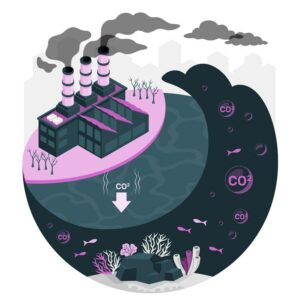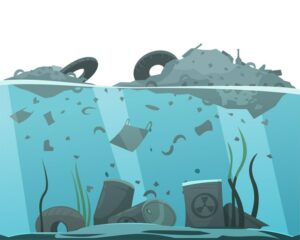Leveraging Oceans for Carbon Sequestration

Harnessing the Power of the Oceans: A Pathway to Carbon Sequestration
The oceans are Earth’s most significant carbon sink, absorbing approximately a quarter of all carbon dioxide (CO2) emissions from human activities. As we face the mounting challenge of climate change, there is an urgent need to explore innovative and effective methods to leverage the vast potential of our oceans to sequester more carbon from the atmosphere. This article delves into the current knowledge and potential strategies surrounding ocean-based carbon sequestration.
Understanding the Ocean Carbon Cycle
Firstly, it’s essential to understand the natural mechanisms of the ocean carbon cycle. The oceans sequester carbon through two primary mechanisms: the biological and solubility pumps.
The biological pump refers to the process whereby photosynthesizing marine organisms, such as phytoplankton, absorb CO2 from the atmosphere, convert it into organic matter through photosynthesis, and then transport it deep into the ocean when they die and sink. This process effectively removes carbon from the surface and stores it in the deep ocean.
The solubility pump, on the other hand, is driven by physical processes. The oceans absorb atmospheric CO2 at the surface, where it dissolves and is carried into deeper waters by ocean currents and mixing. Both pumps operate continuously, helping to regulate global carbon levels and mitigate climate change.
Enhancing the Biological Pump
One of the strategies to increase the ocean’s carbon sequestration capacity is to enhance the biological pump’s efficiency. This can be done through ocean fertilization, which involves the addition of nutrients, such as iron, to stimulate phytoplankton growth.
Iron is a limiting nutrient in many parts of the oceans. The principle behind ocean iron fertilization (OIF) is that by adding iron to these areas, we can stimulate a phytoplankton bloom, which would absorb more CO2 through photosynthesis. Once these organisms die, they sink to the ocean floor, taking the sequestered carbon.
However, OIF has its challenges and potential risks. It could lead to unintended ecological consequences, such as harmful algal blooms, and the efficiency of carbon sequestration through this method is still under debate.
Utilizing Marine Permaculture
Another innovative approach to enhancing the biological pump is through marine permaculture, which involves the creation of underwater forests of kelp and other seaweeds. These marine plants absorb CO2 as they grow, and if harvested and sunk to the deep ocean floor, they can sequester carbon for centuries or longer.
This approach also offers additional benefits, such as habitat creation, water quality improvement, and potential sustainable harvesting for biofuels or other uses. However, large-scale implementation would require significant technological advances and infrastructure development.
Enhancing the Solubility Pump
Ocean alkalinity enhancement aims to increase the solubility pump’s capacity. This involves adding alkaline substances, such as crushed limestone, to the ocean, which increases its capacity to absorb and store CO2.
The principle behind this method is that the added alkaline material reacts with CO2 to form bicarbonate ions, increasing the ocean’s capacity to store carbon. However, like other methods, this approach also comes with challenges, including the need for large amounts of material and the potential for localized impacts on ocean chemistry.
Carbon Capture and Storage
Direct capture and storage of CO2 in the deep ocean has also been proposed as a method for sequestering carbon. This would involve capturing CO2 from point sources, such as power plants, and transporting it to the deep ocean for storage.
However, the potential impacts of this method on deep-sea ecosystems are not yet fully understood, and the risk of leakage is a significant concern. International law# I need to know the current status of international law regarding carbon capture and storage in the ocean.
Legal implications also currently present certain constraints on this method. The United Nations Convention on the Law of the Sea (UNCLOS) does not explicitly regulate carbon capture and storage (CCS) or classify CO2 as a regulated substance or activity12. However, UNCLOS does have regulations that could potentially apply to CO2 pipelines and the transport of CO2 for offshore storage.
For instance, UNCLOS requires states not to transfer damage or hazards from one area to another. If CO2 were to be defined as a pollutant or hazardous substance, it would prevent states from transporting CO2 from the capture site to an offshore storage site.3.
Moreover, the convention divides the sea into different areas where states have different rights and obligations; these rights and obligations may significantly impact transporting CO2, whether by pipelines or ships.
In the territorial sea, the consent of the coastal state is required to lay pipelines. The same rules apply when pipelines cross a state’s territorial sea for offshore storage in the state’s sub-seabed or traverse the coastal state’s territorial sea to reach a storage site elsewhere. However, transport by ship would not require such consent due to the right of innocent passage across territorial waters of other states, provided it is not prejudicial to the peace, good order, and security of the coastal State4.
In the Exclusive Economic Zone (EEZ) and the Continental Shelf, states are free to lay pipelines and are subject to the coastal state’s consent and conditions. The coastal state can prohibit the placement of pipelines if it believes the pipeline would jeopardize its rights or duties, such as its right to explore and exploit its natural resources or its duty to prevent, reduce, and control pollution from pipelines. The coastal state can also impose conditions for pipelines entering its territory or territorial sea and has jurisdiction over their construction and use56.
On the High Seas, the regime of ‘freedom of the high seas’ applies, which includes the freedom to lay submarine cables and pipelines7.
Therefore, while direct capturing and storing CO2 in the deep ocean might seem like a viable solution from a technical standpoint, it would have to navigate a complex regulatory landscape and address potential environmental impacts.
As we grapple with the urgency of the climate crisis, the ocean offers a vast, largely untapped potential for carbon sequestration. However, each method has challenges, including technological hurdles, environmental risks, and regulatory complexities.
Given these challenges, any strategy for ocean-based carbon sequestration? What are the potential ecological consequences of ocean iron fertilization?
What are the technological advancements required for the large-scale implementation of marine permaculture?
What is the current status of international law regarding carbon capture and storage in the ocean?
It must be developed in a balanced and responsible manner. This would require rigorous scientific research.
